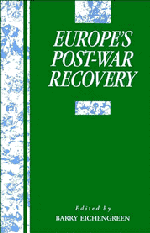Book contents
- Frontmatter
- Contents
- List of contributors
- Preface
- Part I Introduction and survey
- Part II The Marshall Plan
- Part III Other international initiatives
- 4 The IMF and the creation of the Bretton Woods System, 1944–58
- 5 The GATT's contribution to economic recovery in post-war Western Europe
- 6 The European Coal and Steel Community: an object lesson?
- 7 The European Payments Union: an efficient mechanism for rebuilding Europe's trade?
- Part IV Country studies
- Part V Synthesis
- Index
5 - The GATT's contribution to economic recovery in post-war Western Europe
Published online by Cambridge University Press: 07 September 2010
- Frontmatter
- Contents
- List of contributors
- Preface
- Part I Introduction and survey
- Part II The Marshall Plan
- Part III Other international initiatives
- 4 The IMF and the creation of the Bretton Woods System, 1944–58
- 5 The GATT's contribution to economic recovery in post-war Western Europe
- 6 The European Coal and Steel Community: an object lesson?
- 7 The European Payments Union: an efficient mechanism for rebuilding Europe's trade?
- Part IV Country studies
- Part V Synthesis
- Index
Summary
Introduction
The contrast between the decade of economic instability in Western Europe after World War I and the economic recovery established in the decade following World War II is nowhere more evident than in the area of international trade relations. Economic reconstruction following World War I lacked any institutional mechanism to facilitate the reduction of trade barriers that had arisen during the war and had become entrenched thereafter. The political weakness of European countries in trade policy was evident when a proposal for “equality of trade conditions” in a draft League of Nations charter was rejected in favor of a weaker provision for “equitable treatment.” The World Economic Conference in 1927 still found it necessary to call upon governments to remove wartime controls on trade, which included import quotas, licensing requirements, and foreign exchange controls. A decade after its formation, the League of Nations had yet to sponsor any negotiations on liberalizing world trade from high tariffs, and the onset of the depression vanquished any serious prospect of trade reform in Europe and elsewhere.
Yet during World War II, even in advance of official US participation in the conflict, the United States and the United Kingdom already envisioned a post-war world trading system based on reducing all trade barriers and limiting discriminatory tariff preferences. Just two years after Germany's surrender, twenty-three countries established a General Agreement on Tariffs and Trade (GATT) that set rules to restrict national trade policies and even started to decrease tariffs in binding agreements.
- Type
- Chapter
- Information
- Europe's Postwar Recovery , pp. 127 - 150Publisher: Cambridge University PressPrint publication year: 1995
- 7
- Cited by



